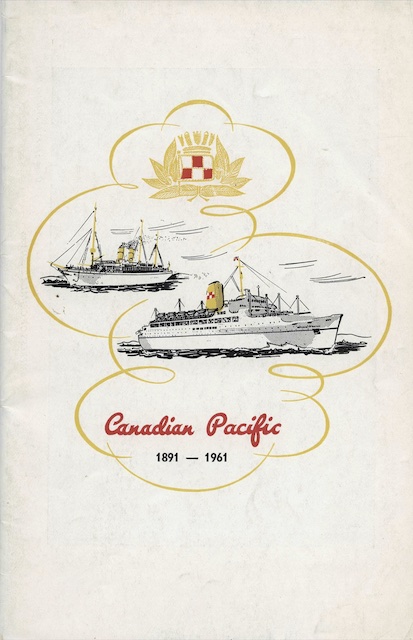Canadian Pacific’s first Empress of Japan made its first revenue voyage in April, 1891, and its last one in July, 1922, thus providing more than 31 years of service during which it made 315 trans-Pacific trips. During two of those years, it had been requisitioned by the British Admiralty during World War I, and were it not for the war it probably would have made about 20 more Pacific trips.
 Click image to view and download a 22.0-MB PDF of this booklet on the history of Canadian Pacific ships through 1961 from the University of British Columbia Chung collection.
Click image to view and download a 22.0-MB PDF of this booklet on the history of Canadian Pacific ships through 1961 from the University of British Columbia Chung collection.
Yet the longevity of the Empress of Japan was unusual. The average empress ship built new for the Canadian Pacific served that company for fewer than 18 years. When counting all passenger ocean liners built for Canadian Pacific, the average service life was less than 15 years. Many made fewer than 100 revenue voyages before being wrecked or impressed into military service and sunk by some enemy torpedo.
All of which makes me wonder how the ocean liner industry was able to financially succeed. Today, the world has plenty of jet airliners, and anyone can lease one and begin a new airline at minimal start-up costs. But building an ocean liner cost hundreds of millions of dollars (in today’s dollars), and there was a high risk that the ship wouldn’t survive long enough to pay off that cost.
No one commissioned an ocean liner expecting it would be sunk after a few trips, but many were wrecked before their time. Of Canadian Pacific’s first three empresses, one was wrecked after 20 years of service. Of its next three, one was sunk after just 8 years. No doubt the war department paid off the shipping companies if their ships were lost in military service, but were the payments truly sufficient to make up for many years of potential revenue?
Today’s modern insurance industry was literally invented to help ship owners cover their losses in the event a ship sinks. But paying insurance premiums only added to the cost of running an ocean liner fleet. Other costs included the crew, a large part of which was fixed no matter how many fare-paying passengers sailed with a ships; fuel, which was substantial enough that Canadian Pacific removed two of the four propellors from the Empress of Britain when it was in cruise ship service to save energy; and food, which we have seen was served to passengers in abundance.
We’ve also seen that the only people who could afford first-class ocean liner service were those who today are called the 1 percent. On one hand, they are somewhat insensitive to price, but on the other hand, they don’t make a very big market. Ocean liner companies made about half their revenue from third-class and steerage passengers, but even they paid high enough prices in today’s dollars that most probably made only one trip as immigrants and rarely if ever returned to their home countries.
Before 1945, ocean liners didn’t have to compete against airlines, but they did have to compete with one another. In trans-Atlantic service, Canadian Pacific probably had to compete with Cunard and at least one other company during most of its ocean liner history. It may have had a monopoly on Vancouver-Asia service but still had compete with ocean liners operating out of Seattle.
Ironically, Canadian Pacific entered the trans-Atlantic market just as a rate war was threatening to put Cunard out of business. The company survived only by getting subsidies from the British government. But that only created a rate war of a different kind, as France, Germany, and the United States also subsidized their flag ocean liner companies in order to have the prestige of the largest, fastest, and/or most luxurious ships between Europe and North America. Canadian Pacific itself only entered both the Pacific and Atlantic markets after securing royal mail subsidies for those routes.
In 1908, the trans-Atlantic companies created a cartel that set minimum fares between North American and Europe. Between 1895 and 1908, revenues on Cunard trans-Atlantic trips averaged around $100 per passenger (about $3,400 in today’s money), but thanks to the cartel they jumped to around $150 per passenger (about $4,500 in today’s money) after 1908.
Given that the companies weren’t competing on price, however, they had to compete based on the luxuriousness of their service, which added to their costs. To earn those higher fares, for example, Cunard built (with the help of British subsidies) the Lusitania and Mauritania, the two largest and most luxurious ships of their time. These two ships added at least $25 to Cunard’s average per-passenger revenues, but also added to its costs.
The Golden Age of passenger trains was from the late 1890s (after recovery from the panic of 1893) to 1929, and it seems likely that the same is true for ocean liners, particularly after the 1908 cartel was created. Most ocean liner companies probably lost money during many years of the the 1930s and were probably happy to yield up their ships to military service in 1939. As has been previously noted here, for example, Canadian Pacific almost certainly made a mistake in ordering a high percentage of first-class cabins for its second Empress of Britain, which probably lost money in most of the eight years that it operated for the company.
Both the railroads and ocean liner companies failed to forecast the growth of airline service after World War II. As the war ended, the railroads invested heavily in new passenger trains, but as early as 1948 it became clear that ridership was rapidly declining, leading the Chesapeake and Ohio to cancel a train before it even made its first regularly scheduled run. The last new passenger train in America was ordered in 1955 and put into service in 1956.
The ocean liner industry lasted only a little longer. Canadian Pacific optimistically put two new ships, the third Empress of Britain and Empress of England, into service in 1956 and 1957. It also began planning what would be its last empress ship, the third Empress of Canada, in 1957. Between then and the time it entered revenue service in 1961, jet airliners began crossing the Atlantic. This probably led the company to regret buying its newest empress, which abruptly ended service after just 11 years, 121 trans-Atlantic trips, and 82 cruises.
CP paid £7.5 million to construct the Empress of Canada, plus more to outfit it for passenger travel. The total cost was probably about $300 million in today’s dollars. After shutting down its trans-Atlantic service, it sold the ship to what would become Carnival Cruise Lines for $5 million, or about $36 million in today’s money. It’s safe to say the company lost money on that ship, and may have also lost money on its immediate predecessors, the third Empress of Britain and Empress of England, whose service lives were also cut short by the jet age.
Economist Bent Flyvbjerg says that government transportation planners are generally guilty of optimism bias, which means they underestimate costs and overestimate benefits. This is no doubt as true of private companies as government agencies. Unless they are subsidized, private companies at least have the virtue that the only money they lose belonged to voluntary investors rather than involuntary taxpayers.
Clearly, the ocean liner industry survived and in some years (particularly the 1920s) thrived before World War II. Even without governments subsidizing the industry, there would have been an ocean liner industry, but probably with fewer companies making fewer sailings. But it seems certain that, if it had it to do over again, Canadian Pacific would have invested a lot less in its ships in the years leading up to 1914, 1930, and 1958.

Bit of a bias showing here in this article, especially in the second-to-last paragraph.
The British government subsidized Cunard quite explicitly for military reasons.
There were plans to convert some liners into armed warships (which ended up not working out all that well, but they didn’t fully appreciate that at the time).
And more importantly, they wanted to maintain strategic military transport capacity. Ocean lift capacity had been understood since the Crimean War, and proved critical all the way through the Falklands War in the 1980s.
Churchill once estimated that the Cunard Queens (Queen Mary and Queen Elizabeth), shortened World War II by a year. Given that they were capable of moving 16,000 troops at a time, and that they could do this with relatively high frequency, this may not be inaccurate. Calculating the costs, human, material, political, and financial, of World War II extending another year can not be estimated, but they are quite certainly higher than any amount of money that could have been put into both ships combined.
Of course, it wasn’t just direct military reasons that prompted government investment.
For nations like Germany, national pride was at stake. There was a tremendous amount of prestige involved in ocean liners, which in turn created what would now be known as “soft power” diplomatically.
And during the Great Depression, construction of ships such as Queen Mary and Normandie served as economic stimulus to help bolster the economy, employing people who otherwise would not have had jobs, which in turn gave them money to spend to help keep other people employed, and so on.
The benefits of transportation projects can be calculated in many different ways, depending on what one is looking to find-hence the saying “lies, damned lies, and statistics”. If you look at a public transportation project strictly through its farebox recovery, then it is likely to make a loss. However, once one broadens the study to include the many externalities of such a project (reduced pollution, economic stimulus, etc.), most public transportation projects have an overall positive value. Roads, on the other hand, have a much smaller overall return because of negative externalities, such as car crashes, additional land consumption for lanes and parking, time wasted in traffic, etc.).
The economist in the second-to-last paragraph appears to be using a flawed methodology that fails to take into account all of the factors noted above, which in turn leads to a flawed conclusion.